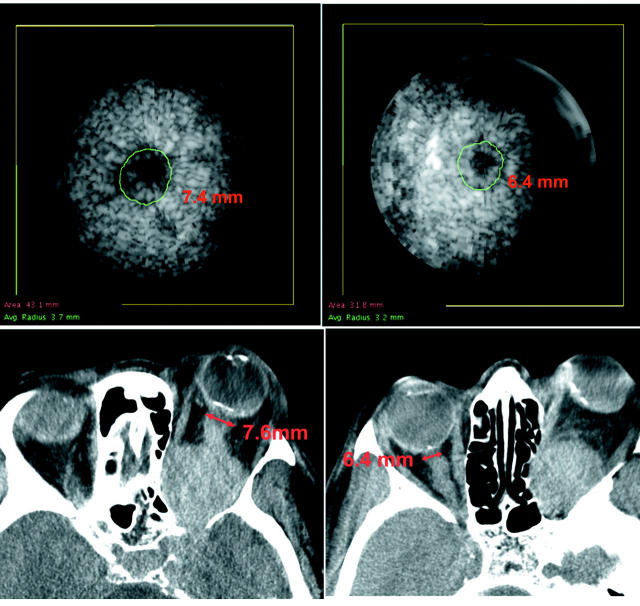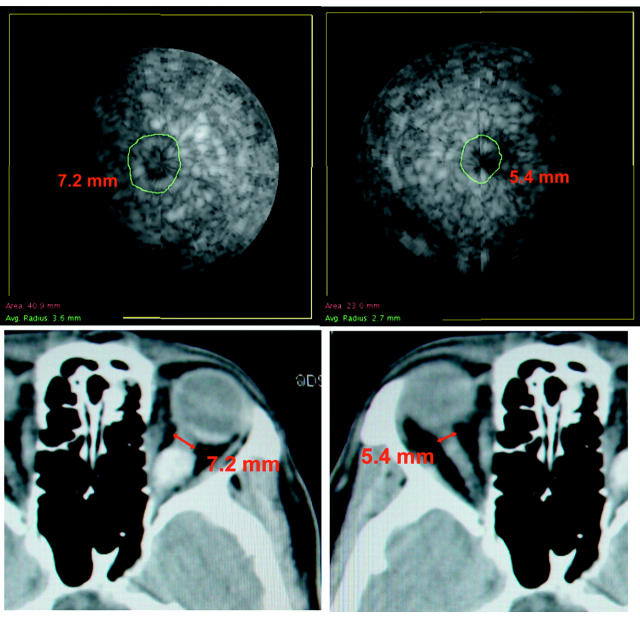The use of three dimensional (3D) ultrasonography (3DUS) for optic nerve measurements has been described in normal eyes utilising coronal “C-scans.”1,2 This study demonstrates the use of 3DUS generated C-scans for optic nerve measurements in orbits with optic nerve sheath meningioma and compares those with measurements obtained from computed tomography (CT) scans.
CASE REPORTS
A 69 year old woman with a left optic nerve sheath meningioma was treated with external beam radiation therapy 6 years earlier. On 3DUS coronal C-scans, an optic nerve sheath diameter (ONSD) 3 mm behind the globe was measured to be 7.4 mm in the left eye (fig 1, top left) and 6.4 mm in the right (fig 1, top right).
Figure 1.
Case 1. The patient’s left (top left) and right (top right) optic nerve sheath diameters are shown by 3DUS coronal C-scans. The patient’s left (bottom left) and right (bottom right) optic nerve sheath diameters are shown by axial CT scans.
CT of the orbits was obtained. The centre of each optic nerve could clearly be identified on the axial imaging. At a distance of 3 mm posterior to the junction of the optic nerve with the sclera, the diameter of the optic nerve was measured. The ONSD was found to be 7.6 mm in the left eye (fig 1, bottom left) and 6.4 mm in the right (fig 1, bottom right).
A 74 year old woman with left optic nerve sheath meningioma was treated by external beam radiation 12 years before our evaluation. On 3DUS coronal C-scan imaging, the ONSD 3 mm behind the globe was measured to be 7.2 mm in the left eye (fig 2, top left) and 5.4 mm in the right (fig 2, top right).
Figure 2.
Case 2. The patient’s left (top left) and right (top right) optic nerve sheath diameters are shown by 3DUS coronal C-scans. The patient’s left (bottom left) and right (bottom right) optic nerve sheath diameters are shown by axial CT scans.
CT of the orbits was obtained. The ONSD 3 mm behind the junction of the optic nerve with the sclera was measured to be 7.2 mm in the left eye (fig 2, bottom left) and 5.4 mm in right (fig 2, bottom right).
COMMENT
C-scan ultrasound imaging provided ONSDs similar to those obtained by CT of the orbits. Each was consistent with tumour related thickening of the left optic nerve. At 3 mm posterior to the globe, an ONSD discrepancy of at least 1 mm between the left and the right eyes was independently observed by both 3DUS C-scans and by CT axial scans.
Values obtained by C-scan correlated well with CT scan measurements. The diameters of the left optic nerves were thicker than the normative CT scan range of 4–6 mm.3 Although the right optic nerve of case 1 was slightly beyond the normative range by 3DUS and by CT, the right optic nerve of case 2 was within normal limits by both tests.
We have found that 3DUS could image the optic nerve up to 15 mm behind the globe. However, the full coronal outline of the optic nerve was no longer apparent starting 7 mm posterior to the globe. Proceeding from this point towards the posterior orbit, parts of the optic nerve sheath outline became indistinct, blending with the blackness of the optic nerve shadow. This is complicated by the twisting manner by which the optic nerve traverses the orbit and sound attenuation that occurs at these distances from the transducer. In contrast, CT allows for a better overall view of the optic nerve (and tumour) as they traverse the orbit.4,5
Three dimensional ultrasound C-scan imaging is a non-invasive, quantitative, and inexpensive method to screen for optic nerve asymmetry and optic nerve tumours.
Supported by The EyeCare Foundation, Research to Prevent Blindness, and The New York Eye and Ear Infirmary Research Fund, New York City, New York, USA.
The authors have no proprietary interest in the equipment used in this study.
References
- 1.Garcia JPS Jr, Garcia PT, Rosen RB, et al. A 3D-ultrasound “C-scan” imaging technique for optic nerve measurements. Ophthalmology 2004;111:1238–43. [DOI] [PubMed] [Google Scholar]
- 2.Liu D, Kahn M. Measurement and relationship of subarachnoid pressure of the optic nerve to intracranial pressure in fresh cadavers. Am J Ophthalmol 1993;116:548–56. [DOI] [PubMed] [Google Scholar]
- 3.Hosten N, Bornfeld N. Imaging of the globe and orbit. New York: Thieme, 1998:16.
- 4.Greene R, Byrne SF. Ultrasound of the eye and orbit. 2nd ed. Philadelphia: Mosby, 2002:273.
- 5.Finger PT. Three-dimensional (3D) ultrasonography of the eye. In: Greene R, Byrne SF, eds. Ultrasound of the eye and orbit. 2nd ed. Philadelphia: Mosby, 2002:236–43.




